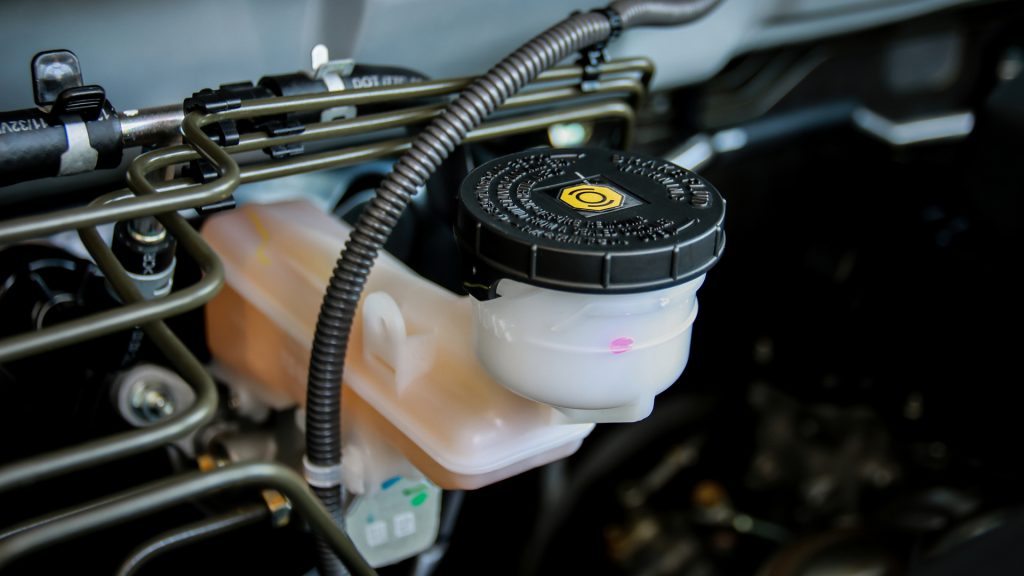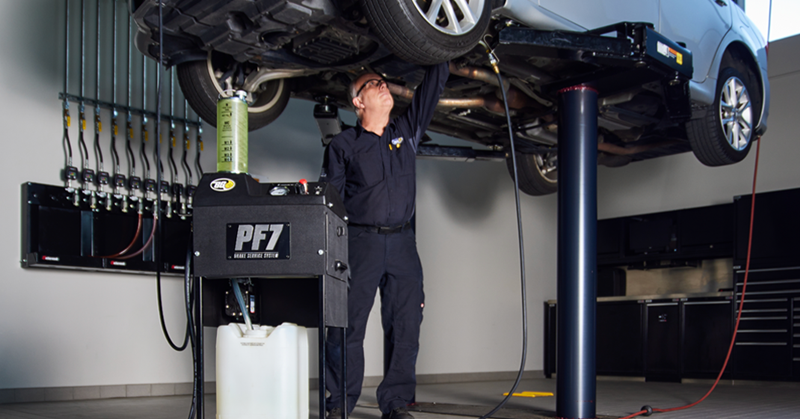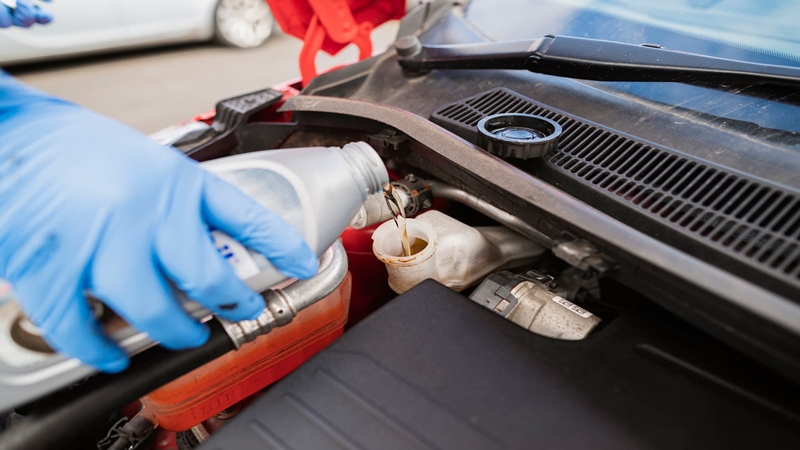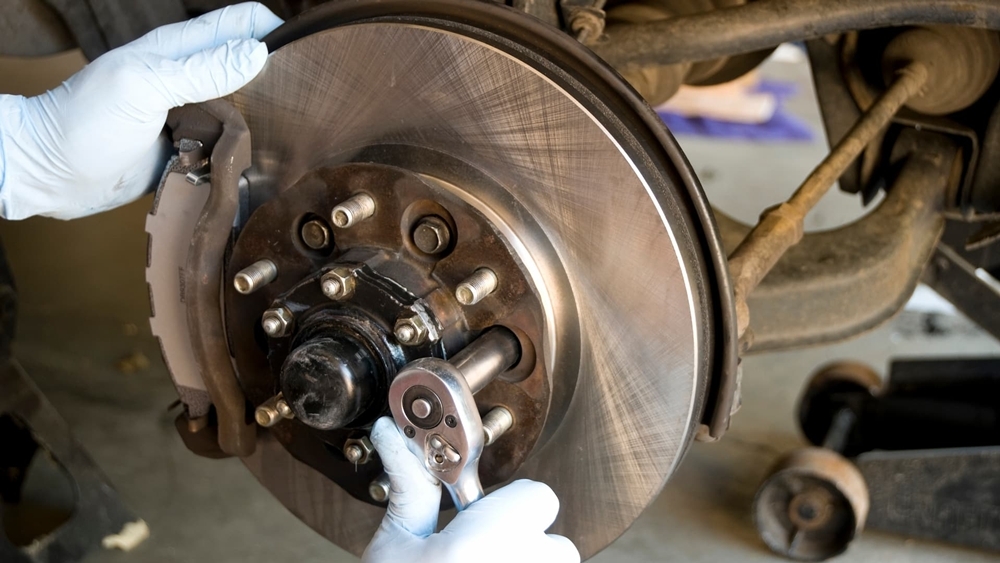Maintaining your car isn’t just about getting new tires or changing oil. Your braking system plays a huge role in keeping you safe on the road. One key part of brake care is a brake fluid flush. But what exactly is brake fluid flush and how much does brake fluid change cost? Let’s break it down.
Table of Contents
Key Takeaways
- Get a brake fluid flush every 2-3 years or 30,000 miles to prevent brake failure and maintain stopping power
- Watch for 7 warning signs: spongy brake pedal, brake warning light, burning smell, unusual noises, inconsistent braking, dark fluid, or overdue maintenance
- Expect to pay $70-$150 for professional service, with costs varying by location, vehicle type, and service provider
- Professional service is recommended over DIY due to safety risks and specialized equipment requirements
- Moisture absorption causes problems: Old brake fluid absorbs water, leading to rust, reduced performance, and potential brake failure
- Choose quality service providers with certified technicians, good reviews, and warranties on their work
- Combine with other brake checks to catch issues early and save money on major repairs
- Safety first: Brake-related issues contribute to 22% of vehicle accidents – don’t skip this crucial maintenance
Also read: Best 3 Types of Brake Pads Compared: Ceramic, Semi-Metallic & Organic
What Is a Brake Fluid Flush?
Brake fluid is what makes your brakes do their job. When you hit the pedal, it sends the force from your foot to the brakes, helping you stop the car. The fluid makes this process smooth. If your brake fluid isn’t in good shape, your ability to stop can really suffer.
What Does Brake Fluid Do?
Brake fluid is key for keeping your car’s brake system safe and working well. It deals with high pressure and heat, so it needs to have a high boiling point to avoid turning into vapor when you’re braking hard. Plus, brake fluid absorbs moisture over time, which can make it less effective and might even cause rust in the brake system. Checking and changing your brake fluid regularly is important to keep your brakes sharp and your driving safe.
Understanding Brake Fluid Types
Not all brake fluids are the same. Using the wrong type can damage your braking system or compromise safety. Here are the main types:
DOT 3 is the most common brake fluid for everyday vehicles. It’s glycol-based with a boiling point of 401°F and works well for standard passenger cars and light trucks.
DOT 4 offers better heat resistance with a 446°F boiling point, making it ideal for performance vehicles, heavy-duty trucks, or frequent towing and mountain driving.
DOT 5 is silicone-based and doesn’t absorb water like DOT 3 and DOT 4. With a 500°F boiling point, it’s perfect for classic cars and long-term storage but can’t be mixed with other types.
DOT 5.1 combines DOT 5’s high heat tolerance (500°F) with glycol-based chemistry, making it compatible with DOT 3 and DOT 4 systems. It’s used in racing and high-performance applications.
Why the Right Type Matters
Using the wrong brake fluid can cause seal damage, brake failure, or void your warranty. Mixing incompatible types (especially DOT 5 with others) is particularly dangerous.
To find your vehicle’s requirement, check your owner’s manual or the brake fluid reservoir cap, which usually shows the DOT specification. When getting a brake fluid flush, always ensure your mechanic uses the manufacturer-recommended type. Your safety depends on proper fluid selection.
Why Is a Brake Fluid Flush Needed?
Over time, moisture sneaks into the brake fluid. When water mixes in, it can cause rust inside the brake system. If you ignore it, you might end up with brake failure or lousy braking. Some signs that you might need a flush include a squishy pedal, longer stopping distances, or warning lights on your dashboard. Most car manufacturers suggest changing the brake fluid every 2-3 years.
Besides moisture, brake fluid can also get dirty with debris and particles from the brake system itself, which can mess with its performance. Dirty brake fluid can lower hydraulic pressure, making it tougher for the brakes to work right.
This can be risky when driving, as the brakes might not respond like they should. Regular maintenance, including a brake fluid flush, helps keep the braking system in top shape, ensuring safety and reliability on the road.

7 Shocking Signs You Need A Brake Fluid Flush
- Spongy or Soft Brake Pedal
If your brake pedal feels unusually soft or sinks too easily when pressed, it may be due to air or moisture in the brake fluid. - Brake Warning Light Is On
The brake warning light on your dashboard could indicate low or contaminated brake fluid that needs to be flushed. - Burning Smell During Braking
A sharp burning odor after braking might signal overheated or degraded brake fluid, which can reduce braking efficiency. - Unusual Noises When Braking
Squealing, screeching, or grinding sounds can result from contaminated brake fluid affecting braking components. - Inconsistent Braking Response
If your brakes feel normal one moment and weak the next, your fluid may be compromised and require flushing. - Dirty or Dark Brake Fluid
Brake fluid should be clear or light amber. If it appears dark, cloudy, or murky, it’s time for a flush. - It’s Been Over 2 Years Since the Last Flush
Brake fluid absorbs moisture over time. If it’s been more than two years, a flush is usually recommended for safety.
Also read: What are brake calipers & 5 alarming signs they are failing
How Is the Brake Fluid Flush Done?
- A professional will first check your brake system.
- Then they drain the old, contaminated fluid. Using special equipment, they flush out dirt, rust, and moisture.
- Next, they refill the system with fresh brake fluid.
- Finally, they bleed the brakes to remove air pockets, making sure everything works perfectly. Safety standards are always followed to keep your brakes reliable.
In addition to the basic steps, a thorough inspection of the brake components is often conducted during the flush process. This includes checking the brake pads, rotors, and calipers for wear and tear, ensuring that all parts are functioning optimally.
If any issues are detected, the technician may recommend repairs or replacements to prevent future problems. Regular brake fluid flushes not only enhance the performance of your braking system but also extend its lifespan, ensuring that your vehicle remains safe and responsive on the road.
How Often Should You Get a Brake Fluid Flush?
Most car manuals recommend changing your brake fluid every 30,000 miles or every two to three years. However, this can change based on your car and how you drive.
For example, if you’re often stuck in heavy traffic, drive through mountains, or do a lot of towing, you might need to change your brake fluid more often because of the extra heat and moisture, which can affect how well your brakes work.
Plus, some cars have specific needs for their braking systems, so it’s a good idea to check your owner’s manual or talk to a trusted mechanic.
Recommended Brake Fluid Flush Schedule
| Driving Condition | Time Interval | Mileage Interval | Why More Frequent |
|---|---|---|---|
| Normal Driving | Every 2-3 years | Every 30,000-45,000 miles | Standard manufacturer recommendation |
| Heavy Traffic/City Driving | Every 18-24 months | Every 20,000-30,000 miles | Frequent stop-and-go creates more heat and stress |
| Mountain/Hill Driving | Every 12-18 months | Every 15,000-25,000 miles | High heat from frequent braking on grades |
| Towing/Hauling | Every 12-18 months | Every 15,000-25,000 miles | Extra weight increases braking demands |
| High Humidity Climate | Every 18-24 months | Every 25,000-35,000 miles | Moisture absorption happens faster |
| Off-Road Driving | Every 12-18 months | Every 15,000-25,000 miles | Dust, debris, and harsh conditions |
| Performance/Track Driving | Every 6-12 months | Every 10,000-15,000 miles | Extreme heat and frequent hard braking |
| Older Vehicles (10+ years) | Every 12-24 months | Every 20,000-30,000 miles | Aging seals allow more moisture infiltration |
| Fleet/Commercial Use | Every 12-18 months | Every 15,000-25,000 miles | High-mileage, constant use accelerates fluid degradation |
Additional Factors That May Require More Frequent Service
Brake Fluid Needed Warning Signs
- Decreased braking performance – Overall reduction in braking effectiveness due to moisture absorption over time
- Spongy brake pedal – Your brake pedal feels soft or sinks too easily when pressed
- Longer stopping distances – Your car takes more time and distance to come to a complete stop
- Brake warning light – The dashboard warning light turns on, indicating potential brake system issues
- High moisture levels – A brake fluid tester shows excessive moisture content in the fluid
- Unusual noises – You hear squealing, grinding, or other strange sounds when applying the brakes
- Brake pedal vibrations – You feel vibrations or pulsing through the brake pedal during braking
When You Need Brake Flush More Often
Driving in humid or rainy climates speeds up moisture buildup. Off-road driving or frequent stop-and-go traffic can also wear out your brake fluid faster. Older cars, or those with high mileage, should get their brake fluid checked more regularly.
Additionally, the type of brake fluid used can influence how often a flush is necessary. Some fluids are more prone to absorbing moisture, while others are formulated to resist it better. Therefore, understanding the specifications of your vehicle and the quality of the brake fluid can help you determine the appropriate maintenance schedule.
Regular inspections by a qualified technician can also catch any potential issues before they become serious, ensuring that your braking system remains reliable and effective.
How Much Does a Brake Fluid Change Cost?
Brake Fluid Flush Price Range
| Service Provider / Type | Average Cost | What’s Included |
|---|---|---|
| Independent Mechanic | $70 – $110 | Flush, refill, brake system inspection |
| Dealership (Standard Vehicle) | $100 – $150 | OEM fluid, system inspection, warranty match |
| Dealership (Luxury/Euro Vehicle) | $150 – $250 | Premium fluid, computer reset, full flush |
| Quick Lube Chains (e.g., Jiffy Lube) | $65 – $120 | Basic flush and refill, less diagnostics |
| DIY (Do It Yourself) | $20 – $50 | Brake fluid only, no labor |
Expect to pay between $70 and $150 for a brake fluid flush. Prices vary depending on where you go, what state you’re in and what kind of vehicle you have.
Brake Fluid Change Price Factors
- Labor costs: Some shops charge more for complex systems.
- Fluid quality: Synthetic brake fluid costs more but lasts longer.
- Extra services: A full brake system check or repairs might add to the price.
DIY vs. Professional Brake Flush Service
Changing brake fluid yourself can save money but it’s tricky. If not done right, you risk brake failure or damage. Best to trust a trained mechanic unless you’re experienced in brake repairs. They have the right tools and knowledge to do the job safely.
Moreover, professional mechanics often have access to advanced diagnostic equipment that can identify underlying issues that a DIY approach might overlook. They can also ensure that the brake fluid used meets the manufacturer’s specifications, which is crucial for maintaining the integrity of your braking system.
Additionally, the peace of mind that comes with knowing a trained professional has handled the task can be invaluable, especially when it comes to something as critical as vehicle safety. In the long run, investing in professional service for brake fluid changes may prevent more costly repairs and ensure your vehicle operates smoothly and safely
Choosing a Brake Fluid Change Provider
Finding the right shop for your brake fluid flush is crucial for your safety. Here’s what to look for:

Essential Qualifications:
- Certified technicians with brake system expertise
- Positive customer reviews and ratings
- Use of high-quality brake fluid that meets your vehicle’s specifications
- Written warranty or guarantee on brake fluid flush service
Service Quality Indicators:
- Clear explanations of the brake fluid flush process and costs
- Willingness to answer your questions about brake maintenance
- Transparent pricing with no hidden fees
- Familiarity with your vehicle’s make and model
Smart Shopping Tips:
- Ask friends and family for brake fluid flush recommendations
- Choose a local shop with experience in your car type
- Get quotes from multiple providers before deciding
- Verify they use the correct DOT-rated brake fluid for your vehicle
Remember, a quality brake fluid flush provider will prioritize your safety and explain why regular brake fluid maintenance matters.
Also read: Power Steering Liquid: 7 Must-Known Facts That Could Save You Thousands
Why Regular Brake Maintenance Is Crucial
Safety Comes First
Your brakes are your vehicle’s most important safety feature. Poor brake maintenance increases stopping distances and can cause accidents. Statistics show that roughly 22% of car crashes result from brake failure. Regular brake fluid flushes and maintenance keep you and your passengers safe.
Save Money in the Long Run
A brake fluid flush costs much less than major brake repairs. Here’s how regular maintenance saves money:
- Early problem detection prevents expensive component failures
- Extended brake life means fewer replacements of pads, rotors, and calipers
- Better fuel efficiency when all brake components work properly
- Avoided emergency repairs that cost significantly more
Neglecting your brake fluid can lead to rotor damage, caliper failure, and complete brake system replacement – repairs that cost thousands instead of hundreds.
Peace of Mind
Well-maintained brakes give you confidence on the road. You’ll enjoy:
- Consistent, reliable stopping power
- Better performance in traffic and bad weather
- Reduced stress during emergency braking situations
- Knowledge that your vehicle is safe for your family
Maximize Your Brake Fluid Flush Service
When getting a brake fluid flush, combine it with a complete brake inspection:
What to Request:
- Brake pad thickness check
- Rotor condition assessment
- Brake line inspection for leaks
- Brake caliper function test
- Overall brake system performance evaluation
Benefits of Combined Service:
- Catch problems early before they become expensive
- Ensure all brake components work together properly
- Get the most value from your service visit
- Maintain optimal brake fluid performance longer
This comprehensive approach during your brake fluid flush helps identify issues before they compromise your safety or require costly repairs.

Take Advantage of Special Offers and Package Deals
Plus, bundling these services can save you both time and cash. A lot of auto shops have package deals for several services, which usually end up costing less than booking each one on its own.
Taking this proactive route not only keeps your ride safe and dependable but also gives you peace of mind knowing you’re taking care of your brakes. Regular check-ups can really cut down the chances of surprise brake problems, making it a smart move for any car owner.
FAQ: Brake Fluid Flush
What is a brake fluid flush?
A brake fluid flush is the process of removing old, contaminated brake fluid from your vehicle’s braking system and replacing it with fresh fluid to maintain optimal braking performance.
How often should I get a brake fluid flush?
Most manufacturers recommend a brake fluid flush every 2 years or 20,000–45,000 miles. Check your owner’s manual for specific intervals.
What happens if I don’t flush my brake fluid?
Old brake fluid absorbs moisture, which can lead to rust, brake line damage, and reduced braking power—potentially causing brake failure.
Can I do a brake fluid flush myself?
Yes, but it requires the right tools, proper fluid type, and knowledge of the bleeding process. DIY is possible, but many prefer to have it done professionally for safety.
How do I know if my brake fluid is bad?
Signs include dark or dirty fluid, a soft brake pedal, brake warning lights, or inconsistent braking.
Is a Brake Fluid Flush a Scam?
No, it’s not a scam—it’s a crucial maintenance service. Replacing old brake fluid with fresh fluid helps keep your brakes working safely and efficiently. Skipping flushes can lead to reduced braking performance and costly repairs, so it’s a smart and necessary part of vehicle upkeep.
Need a mechanic? Find one on the Mobile Mechanic Directory
Final Thoughts
A brake fluid flush isn’t just routine maintenance—it’s a critical investment in your safety. With brake-related issues contributing to 22% of vehicle accidents, spending $70-$150 every 2-3 years is minimal compared to the cost of brake failure or an accident.
Don’t ignore the warning signs we’ve covered, from spongy pedals to dark fluid. Find a certified professional who uses quality brake fluid and stands behind their work. Regular brake fluid flushes ensure your brakes respond when you need them most, giving you invaluable confidence on the road.
Your safety is worth more than routine maintenance costs. Schedule that brake fluid flush and keep yourself and your loved ones protected.





